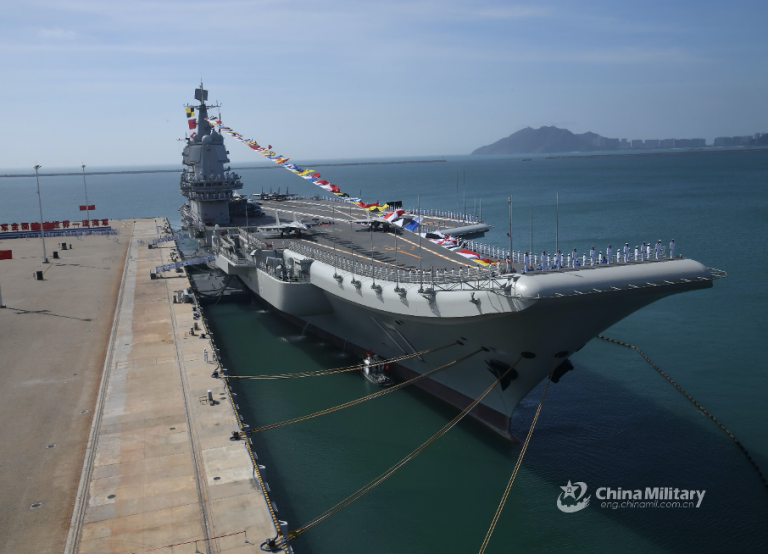
China Monitor is our brand-new program that analyses China’s economic and foreign policies. It also aims to predict the consequences of Beijing’s policy for the global economy, the EU as well as Central and Eastern European countries such as Poland.
Date: 16 September 2020 Author: Paweł Paszak
The naval power of China in the report of the US Department of Defense
The US Department of Defense (DoD) published an annual report to the Congress on the modernization of the People’s Liberation Army (PLA) on September 2, 2020. Media attention was particularly drawn to the fact that China has the largest fleet in the world in terms of number of vessels (350) and that this advantage is expected to increase in the coming years. The real progress achieved by PLA, however, is not equivalent to gaining an advantage over the US Armed Forces, which are still superior in key areas. The DoD report should be seen as a useful review of the growing capabilities of the Chinese army, but at the same time it should be borne in mind that the primary goal of this report is to mobilize support and resources for numerous development programs of the US Armed Forces.

The development of the PLA Navy is one of the most important areas in the PRC’s military strategy and its aim is to increase anti-access/area-denial (A2/AD) capabilities and to enhance the power projection capability in far seas/blue water (远海). In many sectors, China’s progress is indisputable, especially the growing tonnage of launched ships. The scale of advances is illustrated by the fact that between 2015 and 2017 the tonnage of launched PLA vessels was almost twice as high as that of US Navy. Moreover, the change is of a qualitative nature to some extent, as evidenced by the mass production of technologically advanced destroyers. By 2019, six Renhai-class destroyers (Type 055) and 23 Luyang III-class destroyers (Type 052D) were launched in the Chinese shipyards to form the core of the aircraft carrier strike groups. American and Chinese sources agree that the Renhai-class destroyers are a threat to all US Navy vessels in service due to advanced radar systems, electronic warfare systems (EWS) and anti-ship cruise missiles. It is also noteworthy that the number of nuclear-powered submarines (Type 094 and 094a) equipped with CSS-N-14 (JL-2) ballistic missiles, which form one of the pillars of China’s nuclear deterrence strategy, is gradually increasing. The report indicates that another type of submarine (Type 096) carrying a new type of nuclear ballistic missile is currently under development.
In terms of the number of aircraft carriers owned, China’s military remains behind the American forces. At the moment, the balance of power is a ratio of 11:2 in favor of the US and this advantage is enhanced by technological factors. In late 2019, the first self-constructed Shandong aircraft carrier (Type 001A) based on the post-Soviet Liaoning (Type 001) was introduced into service. However, unlike the aircraft carriers of the Nimitz-class and the Gerald R. Ford-class, the vessel lacks nuclear propulsion – a technology which significantly increases the ability to operate in open waters. Furthermore, the combat value of the new aircraft carrier remains limited due to its lower payload and the absence of a classic carrier-based fighter, which is comparable in performance to the F-35C. According to the predictions of the report, the third Chinese aircraft carrier (Type 002) is expected to enter service in 2024, but similarly to its predecessors, it is to be equipped with conventional propulsion.
Support Us
If content prepared by Warsaw Institute team is useful for you, please support our actions. Donations from private persons are necessary for the continuation of our mission.
The priority for the coming years is not only to expand the fleet, but also to replace obsolete Cold War vessels with their modern equivalents. American institutions predict that the Chinese navy will have 425 ships by 2030. It should be noted that a significant part of the vessels in service of the PLA are small (corvettes up to 2,000 tons of displacement) and medium-sized ships (frigates about 4,000 tons of displacement), while in the case of the US Navy its core is represented by missile cruisers (9,000-11,000 tons of displacement) and destroyers (9,000-15,000 tons of displacement).
US forces are deployed in various regions of the world, such as Europe, the Middle East and the Indo-Pacific. On the one hand, this increases Washington’s ability to shape the political situation and project force in these areas, on the other hand, it leads to the dispersion of resources that could be used to balance China’s developments. PLA, though still weaker, is concentrating its efforts in the Western Pacific Region, operating from a continental base. The “Tyranny of Distance” and the related extension of logistical routes in the Pacific are described in the DoD documents as one of the main problems related to power projection. In the coming years, increased efforts by each side to gain an advantage at sea are to be expected, with time likely to favor the Chinese side.
All texts published by the Warsaw Institute Foundation may be disseminated on the condition that their origin is credited. Images may not be used without permission.

















